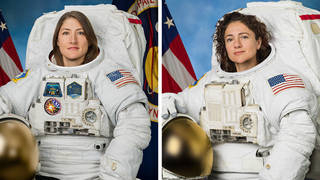The year 2019 was a very fruitful one for NASA. From advancement in space technology aimed at human space exploration to important research that enabled a better understanding of conditions here on earth, 2019 was a year of valuable contributions across various areas for NASA.
One particular area that NASA was able to make strides was sending humans into space many more times. For example, astronauts Anne McClain, Andrew Morgan, Christina Koch, Jessica Meir, and Nick Hague made headlines when they made their first spaceflight missions to the International Space Station and carried out their very first spacewalks.
We bring you a few other highlights of NASA's achievements with respect to putting human beings in space:
- 10 spacewalks were carried out by astronauts from NASA. The walks were aimed at achieving: upgrading of the station's power system, carry out repairs of instruments seeking dark energy, anti-matter and dark matter, and installation of a new docking port for spacecraft of commercial crews.
- For the purpose of understanding the effects of long-duration space travel on the human body, Andrew Morgan and Christina Koch participated in extended missions. Koch became the first woman to undertake the longest single spaceflight.

NASA astronauts Christina Koch and Jessica Meir Credits: NASA NASA - In order to prepare for flight tests on Starliner and Crew Dragon, astronauts from the first Commercial Crew Program flights trained rigorously.
- Unraveling the durability of the human body in pace, NASA also published the results of its 'Twins Study'.
- After a five-day trial mission, SpaceX's Crew Dragon safely returned to earth; prompting SpaceX to prepare in advance for an in-flight abort test for its astronaut carrying flight.
- Collaborating with Boeing, NASA collected data and gained valuable insights from the uncrewed flight test of Boeing's CST-100 Starliner. Unfortunately, it failed to dock with the space station after successfully launching and landing. Achieving an important safety milestone in November, Boeing successfully tested Starliner's abort system.
- Over 32,000 pounds of tools, science investigations and vital supplies were delivered to the space station—10,800 pounds of equipment and investigation were returned to scientists on earth—through five commercial cargo missions.

NASA - A five-point plan to advance a flourishing commercial economy in low-Earth orbit was announced by NASA to make the space station accessible to the US industry.
- These commercial resupply runs helped the crew carry forward over 100 new investigations aimed at advancing human space exploration. It also enabled research meant to benefit human life on earth by the US National Laboratory.
- Some of the research conducted on the space station were directed towards understanding the adaption of human beings to space flight, how to cultivate and harvest vegetables in space, understanding how the shift of fluids affect blood flow in astronauts, measuring atmospheric carbon dioxide, and quantum mechanics and black holes.
- Among other things tested on the space station where a new medical research technology known as tissue chips, a new air quality monitoring system, a virtual reality camera, and a free-flying robot system.









